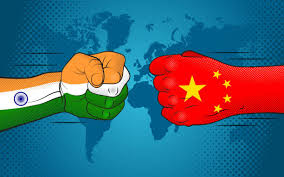Introduction
The India-China border disputes represent one of the most significant geopolitical challenges in Asia today. As two of the most populous and rapidly growing economies in the world, the relationship between India and China holds crucial implications for regional stability, security, and economic development. Understanding the historical context and future implications of these disputes is essential for comprehending their impact on global geopolitics. This essay explores the origins and evolution of the border conflicts, their current state, strategic and economic implications, diplomatic efforts, and future prospects.
Historical Context
Origins of the Disputes
The origins of the India-China border disputes can be traced back to the colonial era, when British India and Imperial China had differing perceptions of their territorial boundaries. The McMahon Line, drawn in 1914 during the Simla Convention, was intended to demarcate the boundary between British India and Tibet. However, China never recognized this line, claiming that it was imposed under duress.
The Sino-Indian War of 1962 was a pivotal moment in the border conflict. The war erupted over conflicting claims in the Aksai Chin region, an area that China had begun to control in the 1950s. The war resulted in a Chinese victory and the establishment of the Line of Actual Control (LAC), which effectively demarcates the current de facto boundary between the two countries. The LAC, however, was never officially delineated, leaving room for ongoing disputes.
Post-War Developments
Following the 1962 conflict, both India and China sought to avoid further escalation. The establishment of the LAC was an attempt to maintain peace, but the lack of a formal border agreement meant that tensions continued. In the 1990s, India and China made concerted efforts to address these issues through diplomatic channels. The 1993 Agreement on the Maintenance of Peace and Tranquility and the 1996 Agreement on Confidence-Building Measures aimed to stabilize the border situation and prevent further conflicts. Despite these agreements, the absence of a clear and mutually agreed-upon border continues to be a source of friction.
Current State of the Disputes
Geographical Disputes
Today, the border disputes primarily focus on two regions: Aksai Chin and Arunachal Pradesh. Aksai Chin, a high-altitude area in the northwestern part of India, is administered by China but claimed by India. Conversely, Arunachal Pradesh, located in the northeastern part of India, is claimed by China as part of South Tibet. The ongoing disagreement over these territories has led to periodic military standoffs and border skirmishes.
In recent years, both India and China have increased their military presence in these contested areas, with infrastructure development such as roads and military installations intensifying the situation. This strategic buildup contributes to the volatility of the border region and complicates efforts to resolve the disputes.
Recent Escalations
The 2020 Galwan Valley clash marked a significant escalation in the border tensions. The skirmish, which resulted in casualties on both sides, highlighted the fragility of the peace agreements and the potential for conflict. Diplomatic responses to this incident included high-level talks aimed at de-escalating the situation, but the clash underscored the persistent challenges in managing the border disputes.
Strategic and Economic Implications
Regional Security
The border disputes have profound implications for regional security. The strategic positioning of both India and China influences their defense postures and military strategies. India’s concerns about China’s growing military capabilities and its strategic alliances, such as with Pakistan, affect its defense policies. Conversely, China’s increasing assertiveness in the Indo-Pacific region impacts its relations with India.
The disputes also influence broader regional security dynamics, including the involvement of external actors and the stability of neighboring countries. Alliances and military strategies in the region are often shaped by the ongoing tensions between India and China.
Economic Interests
The border disputes also affect bilateral trade and economic relations. Despite the conflicts, India and China have developed substantial economic ties, with China being one of India’s largest trading partners. However, trade relations are often strained by geopolitical tensions, which can impact economic stability and growth.
China’s Belt and Road Initiative (BRI) has further complicated the economic landscape. India’s concerns about the BRI, particularly the China-Pakistan Economic Corridor (CPEC) that passes through disputed territories, reflect its apprehensions about regional influence and economic competition.
Diplomatic and Negotiation Efforts
Ongoing Negotiations
Efforts to resolve the border disputes have involved numerous rounds of negotiations and high-level meetings. Recent diplomatic efforts include talks between the foreign ministers and military commanders of both countries aimed at de-escalation and confidence-building. These negotiations seek to manage the immediate tensions and establish mechanisms for conflict prevention.
The effectiveness of these negotiations is often limited by deep-seated mistrust and differing national interests. Both India and China have strategic priorities that influence their negotiation stances, making it challenging to achieve a lasting resolution.
International Involvement
International actors and organizations play a role in mediating or influencing the dispute resolution process. Global geopolitical dynamics, such as U.S.-China relations and regional alliances, affect the context within which India-China negotiations occur. The involvement of external actors can both support and complicate efforts to resolve the disputes.
Future Implications
Potential for Conflict
The potential for future conflict remains a significant concern. The risk of escalation is influenced by several factors, including military deployments, strategic interests, and nationalistic sentiments. Both countries face internal and external pressures that can exacerbate tensions, making conflict management a complex and ongoing challenge.
Impact on Regional Stability
The long-term implications of the border disputes for regional stability are substantial. The unresolved conflicts contribute to uncertainty and volatility in the region, affecting not only India and China but also their neighbors and global stakeholders. Achieving a lasting resolution could contribute to regional stability and improve broader geopolitical dynamics.
Conclusion The India-China border disputes are a multifaceted issue with deep historical roots and significant future implications. The historical context reveals a legacy of conflicting territorial claims and unresolved boundaries, while the current state of the disputes highlights ongoing tensions and strategic complexities. Strategic and economic implications underscore the broader impact of the disputes on regional security and economic relations. Diplomatic efforts and international involvement play crucial roles in managing the disputes, but the potential for future conflict remains a pressing concern. Addressing these challenges requires continued diplomatic engagement, strategic foresight, and a commitment to resolving long-standing issues in order to achieve lasting peace and stability in the region.




